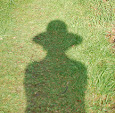There was a Remembrance Service today to mark 100th anniversary of the signing of the World War One Armastice.
Having started primary school in Western Canada in 1950 I have memories of turning out every year at the Salmon Arm Cenotaph. It was always a Big Thing. Being an immigrant culture, it probably still is.
But turning to Scotland, it is a country with a long history providing regiments for war.
Laying of wreaths Milngavie
A local chap, namely I Taggart, who is a sailing friend now in his 90s wearing both his uncle's medals (WWI) and his own (WW2).
The Milngavie Pipe Band outside my favourite coffee shop. (In the 1950s it was always the Vernon Girls Pipe Band that turned out for our small town. I absolutely loved it ... still do!)
* * * * * * *
THE PAST: FAMILY CONNECTIONS (THESE MEN SURVIVED THE WAR)
The grandchildren ask questions ….
[1] Why red poppies?
In the spring of 1915 a
Canadian doctor, Lieutenant Colonel John McCrae was inspired by the
sight of poppies growing in battle-scarred fields to write a now famous
poem called 'In Flanders Fields'. After the First World War, the poppy
was adopted as a symbol of Remembrance.
The
exact battle he was involved in was during the Second Battle of Ypres
in Belgium when the German army launched one of the first chemical
attacks in the history of war. They attacked the Canadian position with
chlorine gas on 22 April 1915.
I recall being told that my grandfather Rev. Victor H. Sansum [b. 1893 d. 1958] was gassed during the war. Having found no other reference to the use of gas I deduce it was on this occasion. He was in the Canadian Expeditionary Force in France. His regimental number was 628122 and buried in Vancouver.
[Photo: outside his house, 2843 MacDonald Ave, Vancouver probably late 1940s or early 1950s]
[2] What’s a ‘volunteer’?
Like so many of his generation Iain’s father [b. 1898 d. 1976] lied about his age in order to enlist. He joined the Seaforth Highlanders.
Like so many of his generation Iain’s father [b. 1898 d. 1976] lied about his age in order to enlist. He joined the Seaforth Highlanders.
As a young man. He escaped the Battle of the Somme because his platoon sergeant pulled him out as there was a requirement from another regiment for a farrier i.e. someone who could shoe horses.
This is Iain's mother's father: Sergeant John MacKenzie, Seaforth Highlanders. She was always known as Barbara 'Sergeant' [MacKenzie].
He was based in Gairloch, Wester Ross.
Caption reads: DEPOT AND ?7 TH (SERVICE) BATTALION SEAFORTH
HIGHLANDERS FORT GEORGE 1914
John MacKenzie is 3rd right, 2nd row from bottom
Postcard to J. MacKenzie, with regiment number.


These give the idea of the dress. Note bell tents in left hand image. We think these are Iain's mother's [MacKenzie] cousins, Gairloch. The uniform shown in the lower image appears similar to cenotaph photo at the beginning of this post.
Here is a photo I took recently. It is a gravestone that lies in the cemetery adjacent to St Magnus Cathedral, Kirkwall, Orkney. I do not know the person, J MACKAY; it was the date that struck me. He died 11th November, 1918.
















No comments:
Post a Comment